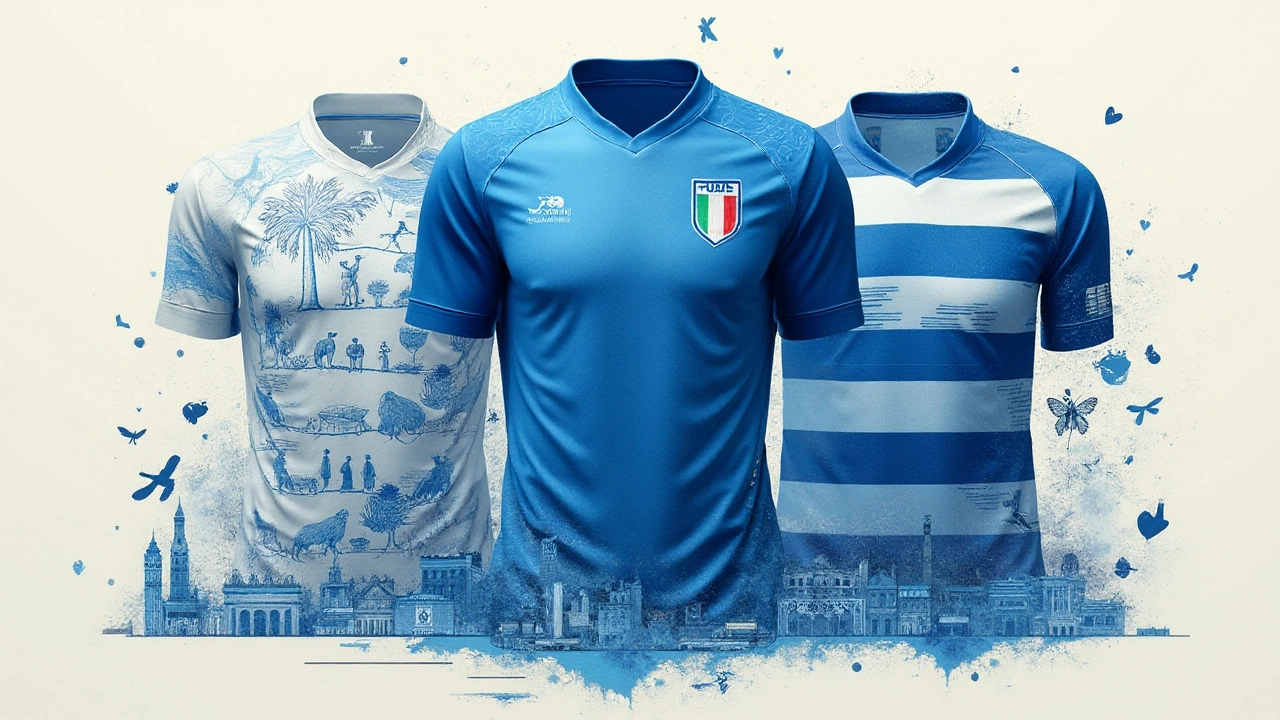Italy's rugby team donning blue jerseys may seem like a curious choice, especially considering the Italian flag's absence of the color. But this choice is not without reason. The color blue, or 'Azzurro', holds a special place in Italian history and culture, representing royalty, unity, and the spirit of the nation. It's a tradition that dates back over a century, connecting the sport with Italy's broader cultural narratives.
This article embarks on a journey to uncover why Italy's rugby team chose blue, shining a light on a color that has come to symbolize much more than just an athletic uniform. From the historical roots and cultural significance of 'Azzurro' to its influence on the team's identity and connection with fans, we explore the unwavering bond between a nation and its favorite hue.
- Historical Origins of the Blue Jersey
- Symbolism of 'Azzurro' in Italian Culture
- Evolution of the Italian Rugby Kit
- Comparison with Other Italian Sports
- Impact on Team Identity and Fans
Historical Origins of the Blue Jersey
The choice of blue for Italy's rugby jersey might initially come across as puzzling, especially since the Italian flag comprises green, white, and red. However, the color blue, known as 'Azzurro' in Italian, has deep-seated historical roots that date back to a time of royal significance. The House of Savoy, a noble dynasty that played a pivotal role in unifying Italy as one nation, had blue as their official color. This royal blue became a symbol of Italy's aspirations, unity, and patriotic spirit. From the late 19th century, when national sports teams began emerging, this color was adopted as a tribute to the legacy of the Savoy family, deeply influencing the national consciousness.
As Italy ventured into the international sports arena in the early 20th century, the adoption of blue signified a nod to tradition and pride. The first official sporting association to use blue was the Italian Football Federation in 1911, followed closely by other sports including rugby. It was more than just a fashion statement; it was a representation of Italy on the world stage, creating a national identity at a time when Italy was still forging its own unified narrative. This decision solidified 'Azzurro' as an emblem of Italian teams across various disciplines, poignantly expressing a patriotic fervor.
Over the years, the use of blue has been consistent; its presence is not just limited to rugby or football but extends to many other sports, tying them together under a shared heritage. The rugby team's blue jersey has become an integral part of its identity and history. Fans associate this color with a legacy that has witnessed both triumphs and tribulations, tying each generation of players to the giants of the past. It’s a fascinating glance into how history, tradition, and sports interweave, providing a sense of continuity and pride for supporters.
"The color blue is not merely about aesthetics; it stands for our roots, our history. It is a constant reminder of where we've come from and what we represent," remarked a former president of the Italian Rugby Federation.
Stories abound of how blue has continually unified and inspired players and fans alike. Each time they don the blue jersey, it's a tribute not only to the sport but to an entire nation's rich heritage. Witnessing the sea of blue in the stands during a match offers an unforgettable experience, serving as an emotional touchstone for both players and supporters. As the Italian rugby team takes to the pitch in their iconic jerseys, they are cloaked in a century-old tradition that connects them with fans, history, and national pride.
Symbolism of 'Azzurro' in Italian Culture
The color blue, known as 'Azzurro' in Italian, holds a special spot in the heart of Italian culture, transcending its use in sports uniforms like the bright jerseys of the Italy rugby team. Identified as a symbol of elegance, prestige, and heritage, this enchanting shade is deeply rooted in Italy's past, dating back to the royal House of Savoy. From the 14th century onwards, the House of Savoy had a flag featuring a silver cross on a blue field, which soon became synonymous with Italian unity and perseverance. As Italy moved towards unification in the 19th century, 'Azzurro' was embraced as a national symbol during the Risorgimento movement. Many consider it an emblem of the Italian monarchy, a sentiment that lingered long after the monarchy's formal end.
Within the fabric of Italian society, 'Azzurro' also finds expression in art, religion, and fashion. Renaissance artists, for instance, utilized rich blue pigments to craft breathtaking depictions of sacred scenes, associating the color with divinity and the heavens. In a nation revered for its artistic and fashion-forward innovations, blue is a consistent favorite in haute couture, equated with modernity and chic. Italians themselves often view 'Azzurro' as a color that radiates calm yet captures attention, the same way it does on the international sports stage. Interestingly, the use of blue distinguishes the Italian national teams from other countries whose uniforms boast colors of their national flags.
"The color blue, symbolic of the House of Savoy and by extension the nation of Italy, is complex and evocative. On the field, it brings a sense of heritage and pride that is decidedly Italian," said noted historian Giuseppe Vignoli.
When it comes to sporting events, the color permeates more than just the attire of the Italian national team. Fans often don 'Azzurro' shirts, scarves, and hats to show solidarity, uniting under the banner of this symbolic hue. Crowds at the stadium become a sea of blue, evoking both nostalgia and unity among spectators. This rallying use makes blue a symbol of both individual pride and nationalistic fervor. There’s an intensity to this shade that resonates during matches, creating a unique sense of belonging among supporters. For Italy, the color symbolizes the seamless blend of historical influence with contemporary national identity, deeply embedded in every celebration of athletic prowess. Rugby uniform aside, these emotional ties amplify the color’s significance, weaving it into the country's collective memory.

Evolution of the Italian Rugby Kit
The journey of Italy's rugby uniform, particularly its iconic blue hue, is a fascinating narrative that speaks volumes about the nation's pride and identity. When Italy first took to the rugby field in the early 20th century, the choice of blue was deliberate, tracing back to the royal House of Savoy, whose heraldic color was 'Azzurro'. This flattering shade of blue was not merely a tribute to royalty. It symbolized a unifying force across a nation richly woven with cultural diversity. As the sporting world became more commercialized in the decades that followed, the Italian rugby kit evolved, adapting to modern fabrics and designs while maintaining its traditional aesthetics. It's intriguing to observe how the Italy rugby team consistently blends comfort, performance, and symbolism in their apparel design.
In the 1970s, advancements in fabric technology began to influence athletic uniforms worldwide, and Italy was no exception. The rugby jerseys shifted from heavy cotton to lighter, synthetic materials, enhancing players' agility and comfort on the field. This shift was crucial as it allowed for better performance in the rigorous demands of international rugby. By the 1980s, the kit had not only improved in functionality but also became a canvas for sponsors, showcasing a balance between tradition and the commercial realities of professional sports. This era saw the introduction of vivid, culturally significant designs, subtly incorporating the Italian flag's red, white, and green, creating a striking contrast against the deep blue.
The 1990s brought a wave of branding, with companies collaborating to optimize the ergonomics of the rugby uniform. With Italian fashion acumen influencing sportswear, the jerseys adopted tailored fits, accentuating athletic builds and enhancing aerodynamics during play. Italian brands, renowned worldwide for their style and quality, did not just view these kits as sports apparel but as a statement of national identity, innovation, and style. The designs were not only eye-catching but meticulously crafted, allowing players to don their country's colors with immense pride.
"Our jerseys tell a story; they're not just for the game but represent every Italian proudly," explained a former national team player. This sentiment encapsulates the emotional connection between the team, its fans, and the country.
Moving into the new millennium, the emphasis on sustainability began influencing the design and production of the Italian rugby kit. Recycled materials and ethical production practices became central themes, aligning with global ecological imperatives. Today, Italy's rugby jerseys reflect a blend of heritage and modernity, showcasing technological advancements while staying true to their historical roots. In this ever-evolving landscape, the Azzurro jerseys continue to capture the hearts of fans and players alike, becoming an indivisible part of Italy's sporting tapestry.
Data on Kit Evolution
| Decade | Material | Design Focus |
|---|---|---|
| 1920s | Heavy Cotton | Traditional, Royal Blue |
| 1970s | Synthetic Blends | Lightweight, Performance-Oriented |
| 1990s | Tailored Fits | Branding and National Identity |
| 2000s | Eco-Friendly Materials | Sustainability and Innovation |
Comparison with Other Italian Sports
Italy is a nation passionate about sports, with its national colors making frequent appearances across a variety of arenas. Interestingly, many Italian sports teams wear blue jerseys too, a nod to the country's royal heritage, known as the House of Savoy, whose heraldic blue has transcended generations. In football, known locally as 'calcio', the blue kit of the Italian national team, Italy rugby's counterpart, is revered worldwide. Much like in rugby, sporting the color blue in football is about carrying forward a legacy that resonates with national pride and unity. As fans chant 'Forza Azzurri', which quite literally means 'Go Blues', it becomes clear that blue isn't just a color but an emblem of Italian sporting identity.
The same holds for Italy's basketball team, which battles on the court to maintain the nation's formidable sporting reputation. Their blue uniforms create a visual consistency, standing as a unifying factor among the country's diverse range of athletes. Keeping consistent with the identity, this hue helps set them apart and often intimidates opponents who understand the weight such a legacy carries. In volleyball, another beloved sport, the Italian team fiercely competes in blue, working as a testament to the versatility yet consistency of this color across sports.
This color choice isn't limited to team sports. Even individual athletes don blue in international competitions, like cycling's Giro d'Italia, where the leader wears a pink jersey, but the country's best often sport blue kits. The consistent theme across these varied sports highlights a country deeply connected to its traditions, making blue jersey a symbol and a unifying emblem for Italian excellence in international sporting events.
While blue is a clear and common element in Italian sports uniforms, its presence and symbolism act as a testament to Italy's loyalty to its historical roots. Given this ubiquity, one might question why Italy never adopted the colors of its national flag—green, white, and red. The answer lies in the long-standing tradition and the emotional value the color blue holds, far surpassing mere representation or team cohesion. This cultural significance is recognized not just personally but officially, as noted by the President of the Italian National Olympic Committee, who stated, "In our colors, we carry our history, our pride, and our vision for the future."

Impact on Team Identity and Fans
When we talk about the identity of the Italian rugby team, the iconic blue jersey is more than just a piece of clothing. It is a symbol that unites players and fans alike, transcending the boundaries of sport. The distinct color choice of the Italian national rugby team, affectionately known as 'Azzurri,' roots itself deeply not only in the heritage of Italy but also in the team’s spirit and character on the field. This vibrant blue embodies the heart and soul of the nation, creating a unique sense of unity and pride among fans that cannot be underestimated. This sense of pride is visible in the roaring chants during matches and the passionate support from the stands.
Much like Italy's rugby team, other national teams wear colors that have profound meanings, shaping and reinforcing fan identity. Fans wearing blue, whether at the stadium or at home, report feeling as though they are themselves part of the match—a sentiment that anyone who has attended a professional rugby match will immediately understand. Italy rugby games are not just about skills and tactics on the pitch; they are an experience, a coming together of a community of supporters enveloped in a singular hue that represents them all. Researchers have often established that colors can influence behavior, emotions, and mental states, contributing to the compelling energy in sports arenas filled with a sea of blue. This shade, historic and emblematic, becomes a banner under which fans unite, sharing the joys and setbacks of each match.
The resonance of 'Azzurro' stretches even beyond the matches. In social settings, fans commonly identify themselves with the team by integrating blue into their daily wear. Some theorists suggest that identifying with a team through its colors provides a sense of belonging and community. This connection often resonates with more than just rugby enthusiasts; it pulls in a wider segment of society, creating a sense of camaraderie among generations, linking the old with the young each rugby season. Parents, like myself with my son Carson, often find these matches an opportunity for bonding, adding a cultural layer to a legacy of strong engagement with sports. The shared experience of supporting a team, defined by its iconic blue, creates life-long memories and lasting impressions.
"The passion for our national team is something that has been embedded in the blue of our hearts; it is not just fabric, it is history," noted a senior player, reminiscing about the deep-rooted cultural heritage tied to their blue jersey.
Additionally, the financial aspect can't be overlooked. The sales of merchandise, especially the iconic jerseys, are a vital part of team funding. Jerseys flying off the shelves during tournaments hint at the massive fan base eager to sport their team’s colors. The investment by fans showcases their unwavering support, driving revenues which feed back into the sport, ensuring better facilities and training for budding players. It represents an economic cycle fueled by passion. This cycle not only benefits the teams but also contributes to local economies, especially during large tournaments attracting international visitors.
The historical and cultural significance of the blue jersey carries multifaceted impacts on the team and its followers. Whether through an adopted tradition or a continuing legacy, the distinctive blue has become synonymous with Italian pride—a beacon symbolizing more than a hundred years of sportsmanship. For Italy's rugby team and its dedicated supporters, the blue jerseys represent identity, resilience, and heritage. It's a rallying cry, a reminder that no matter where they are in the world, they share an indelible bond, woven by generations before them, showcased in every match they play.

